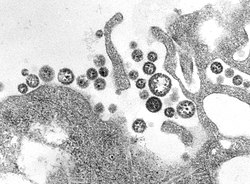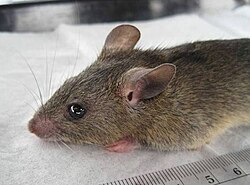Lassa fever
Lassa fever or Lassa hemorrhagic fever (LHF) is a fever caused by the Lassa virus. It is common in West Africa. One in 80 people who get Lassa fever will die.[1] Some cases are severe and require going to a hospital. These cases have a death rate of 1 in 5. Lassa Fever was discovered in 1969 after two nurses died from the disease.[2] It was named for the town in Borno State, Nigeria where it was first diagnosed.[2][3]
How people get Lassa fever

Lassa fever is transmitted from rodents to humans. It is caused by direct contact with rodent droppings.[4] It can also be transmitted by humans to other humans by their blood. Lassa fever is common in West and Central Africa (around the equator).
Lassa fever cannot be transmitted by breathing. It is not very contagious between humans. However it is much more contagious among seriously ill patients. Lassa fever is transmitted by humans through skin lesions, mucous that is exposed to the virus, or by a patient's blood. This means healthcare workers (such as doctors and nurses) need to be especially careful in treating patients, or they risk getting the virus themselves.
Symptoms of Lassa fever
In 80% of cases, the disease does not have any symptoms and does not make people ill. In the other 20% of cases it shows symptoms and becomes much more severe.[4] About 5,000 people die from it each year.[4]
In infected patients, the disease has an incubation period of 5 days to 3 weeks.[5] During this time, the virus remains dormant and does not cause harm. After this time various symptoms begin to appear including:
- Vomiting (with blood)
- Diarrhea (with blood, dysentery)
- Nausea
- Stomach ache
- Constipation
- Difficulty Swallowing
- Coughing
- Seizures
Diagnosis and treatment
In laboratories, there are many ways to test if a patient has Lassa fever. However, in many of the affected regions, there is no equipment to do the tests. This means sometimes people may not be correctly tested and identified with having Lassa fever.
If a patient is diagnosed with Lassa fever, then the patient will be kept away from other people, to prevent the spread of the virus. If found early, it is possible to treat Lassa fever with the medicine Ribavirin. Despite the fact the drug is relatively cheap, the medicine is still considered expensive for many people in affected regions. Patients may also require blood transfusions and rehydration.
Pregnant women in their 3rd trimester may need their baby's birth to be induced to allow them to have a chance of survival.
Due to the use of Ribavirin, fewer people are dying from Lassa fever.
Prevention
It is not practical to control the amount of rodents in the affected states. Therefore the best way of prevention is to keep rodents out of houses and public areas to prevent people coming into contact with infected droppings. Infected patients should also be isolated to prevent the spread of the virus (by humans to other humans). In rich countries, diseases such as Lassa fever can be easily monitored by public health organisations to prevent outbreaks. Poor countries often cannot afford these services.
There is a vaccine which has shown promise in primates. It has not yet been proved effective in humans.
Lassa Fever Media
Liberian laboratory technicians in personal protective equipment preparing to test Lassa fever samples.
References
- ↑ Ogbu O, Ajuluchukwu E, Uneke CJ (2007). "Lassa fever in West African sub-region: an overview". Journal of Vector Borne Diseases. 44 (1): 1–11. PMID 17378212.
{{cite journal}}: CS1 maint: multiple names: authors list (link) - ↑ 2.0 2.1 "Lassa Fever". Centers for Disease Control and Prevention. 25 March 2014. Retrieved 11 October 2014.
- ↑ "The Facts on Lassa Fever". The Communicator Online. Archived from the original on 2020-08-14. Retrieved 2018-07-12.
- ↑ 4.0 4.1 4.2 Marshall Cavendish Corporation, Diseases and Disorders, Volume 2 (New York: Marshall Cavendish, 2007), p. 502
- ↑ Tirtha Chakraborty; et al., Dengue Fever and Other Hemorrhagic Viruses (New York: Chelsea House, 2008), p. 26
Other websites
- WHO factsheet
- CDC info—viral fevers
- Health Protection Agency - viral haemorrhagic fevers Archived 2013-06-05 at the Wayback Machine
- Merlin[dead link]
- Map
- Emerging Infectious Diseases, CDC Archived 2014-03-06 at the Wayback Machine





